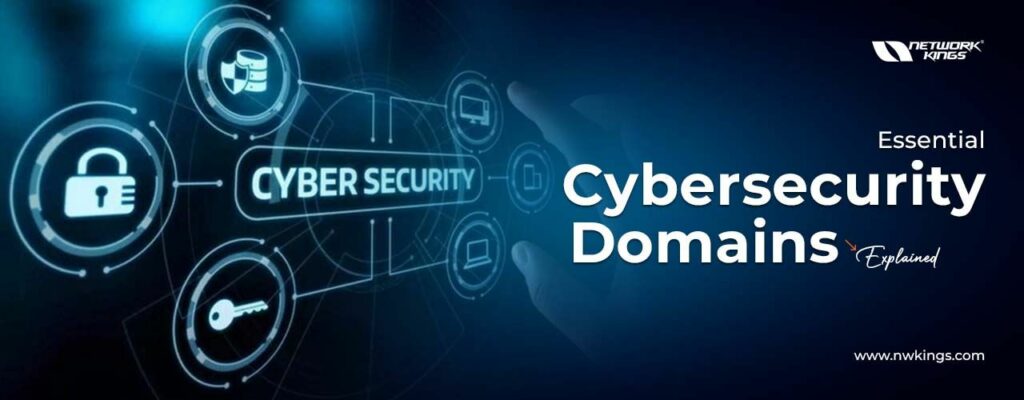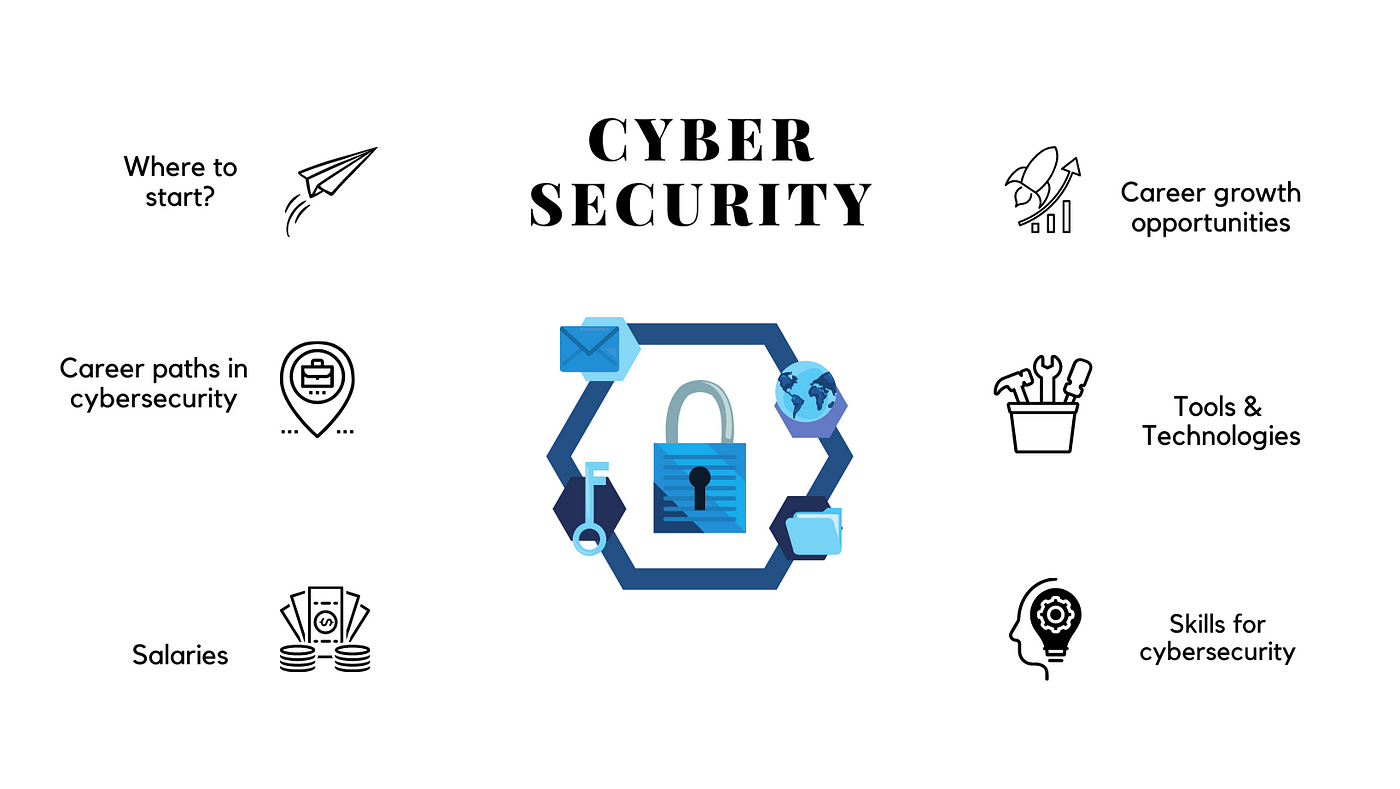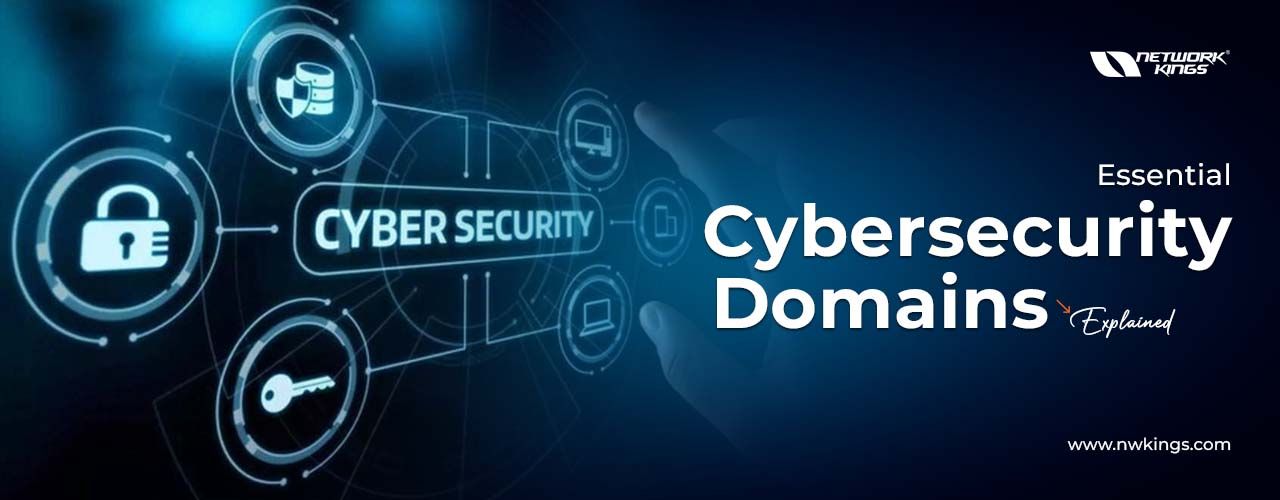
In our present-day world, where computers are at the heart of many activities, we simply cannot underestimate cyber safety measures as this digital landscape holds precious assets which have to be protected adequately. This blog post will take us on an expedition into understanding cybersecurity by examining its core components so that companies or individuals may gain cleverness into how threats such as malware or data breaches can efficiently be warded off. Let’s explore the top cyber security domains in detail.
What are the top available cyber security domains?
The top available cyber security domains are as follows-
- Network Security (Protecting computer networks from unauthorized access or attacks)
Network security is the practice of safeguarding computer networks from unauthorized intrusion, data breaches, and cyberattacks. This domain involves implementing a range of measures such as firewalls, intrusion detection systems, access controls, and VPNs to create a secure network environment. It aims to ensure the confidentiality, integrity, and availability of network resources, preventing unauthorized users from accessing sensitive data or compromising network functionality.
- Information Security (Ensuring the confidentiality, integrity, and availability of sensitive information)
Information security encompasses strategies and controls designed to protect sensitive data from unauthorized access, modification, or destruction. It addresses the confidentiality (keeping data private), integrity (ensuring data accuracy and reliability), and availability (making data accessible when needed) of information. Information security measures include encryption, access controls, data classification, and security policies to safeguard critical data assets.
- Cloud Security (Securing data and applications hosted in cloud environments)
Cloud security focuses on securing data, applications, and services hosted in cloud platforms. It involves managing access controls, data encryption, and monitoring to protect against cloud-specific threats, ensuring data confidentiality, integrity, and availability in cloud environments.
- Application Security (Protecting software applications from vulnerabilities and threats)
Application security is concerned with identifying and mitigating vulnerabilities in software applications to prevent exploitation by cybercriminals. It encompasses secure coding practices, code reviews, penetration testing, and the use of security tools to identify and remediate application weaknesses, reducing the risk of data breaches and application-level attacks.
- Endpoint Security (Securing individual devices like computers, smartphones, and IoT devices)
Endpoint security focuses on securing individual devices, including computers, smartphones, and IoT endpoints, from various cyber threats. It involves installing antivirus software, and intrusion prevention systems, and conducting regular device patching and updates to protect against malware, ransomware, and other threats.
- Identity and Access Management (IAM) (Managing user access and authentication)
IAM is the practice of managing user identities, authentication, and access to systems and resources. It involves setting up user accounts, defining role-based access controls, and implementing multi-factor authentication to ensure that only authorized users can access specific resources, reducing the risk of unauthorized access.
- Security Operations (SecOps) (Monitoring and responding to security incidents)
SecOps combines security and operations to monitor and respond to security incidents in real time. Security analysts use tools and processes to detect and mitigate threats, ensuring the security posture of an organization, and minimizing the impact of security breaches.
- Incident Response (Managing and mitigating security breaches)
Incident response is the organized approach to managing and mitigating security incidents when they occur. It involves identifying, containing, eradicating, and recovering from security breaches to minimize damage and prevent further incidents, including legal and reputational repercussions.
- Threat Intelligence (Collecting and analyzing information about cybersecurity threats)
Threat intelligence involves gathering and analyzing data on potential cybersecurity threats and vulnerabilities. This information helps organizations proactively defend against emerging threats by understanding attacker tactics, techniques, and procedures, and by making informed decisions about security measures.
- Cryptography (Securing data through encryption and decryption techniques)
Cryptography is the science of securing data through encryption and decryption techniques. It ensures data confidentiality by converting information into an unreadable format that can only be deciphered with the appropriate cryptographic key, protecting data from unauthorized access or interception.
- Security Awareness and Training (Educating users about cybersecurity best practices)
Security awareness and training programs educate users within an organization about cybersecurity best practices and potential threats. By raising awareness and providing training, organizations reduce the risk of human errors and social engineering attacks, enhancing overall security.
- Mobile Security (Protecting mobile devices and apps from threats)
Mobile security focuses on safeguarding mobile devices like smartphones and tablets, as well as the apps running on them. It includes secure app development, mobile device management, encryption, and measures to protect against mobile-specific threats such as mobile malware and data leakage.
- Physical Security (Securing physical locations, data centers, and hardware)
Physical security involves protecting physical locations, data centers, and hardware from unauthorized access, theft, and environmental threats. It encompasses measures like access controls, surveillance, alarms, and disaster recovery planning to ensure the safety of physical assets.
- IoT Security (Ensuring the security of Internet of Things devices and networks)
IoT security is dedicated to ensuring the security of Internet of Things (IoT) devices and networks. It involves device authentication, encryption, network segmentation, and monitoring to prevent IoT-related vulnerabilities and protect against IoT-based attacks.
- Industrial Control Systems (ICS) Security (Protecting critical infrastructure)
ICS security focuses on safeguarding critical infrastructure such as power plants, manufacturing facilities, and utilities. It includes measures like network segmentation, intrusion detection, and vulnerability assessments to protect operational technology (OT) systems from cyber threats.
- Risk Management (Assessing and mitigating cybersecurity risks)
Risk management involves identifying, assessing, and mitigating cybersecurity risks within an organization. It encompasses processes to evaluate vulnerabilities, analyze potential impacts, and implement controls and strategies to reduce or transfer risk effectively.
- Compliance and Regulatory Compliance (Ensuring adherence to cybersecurity regulations)
Compliance efforts aim to ensure that an organization adheres to cybersecurity regulations and standards relevant to its industry. This includes activities such as policy development, audits, and assessments to maintain legal and regulatory requirements and mitigate compliance-related risks.
- Insider Threat Detection (Identifying and addressing threats from within an organization)
Insider threat detection involves monitoring employee activities and behaviour to detect potential malicious intent or actions from within an organization. It includes user behaviour analytics, access controls, and policies to mitigate risks associated with insider threats.
- Supply Chain Security (Securing the supply chain to prevent compromises)
Supply chain security focuses on securing the entire supply chain to prevent compromises that could impact an organization’s security. It involves assessing and monitoring the security of vendors, suppliers, and partners to reduce third-party risks.
- Security Architecture and Design (Designing systems with security in mind)
Security architecture and design involve designing systems, applications, and networks with security as a primary consideration from the outset. It includes defining security requirements, implementing security controls, and conducting security reviews throughout the development lifecycle to create robust, secure systems that can withstand threats and vulnerabilities.
How to Grow in the Cybersecurity Domain?

Advancing your career in cybersecurity requires dedication to regular learning since this domain is always evolving. The following are necessary moves for building up your skillset within cyber security:
- Education & Certification
Begin by having reliable academic background. Pursue a degree in cybersecurity or related fields. Earn your degree and stand out from the competition. Get industry-recognized certifications such as CompTIA Security+, Certified Information Systems Security Professional (CISSP), or Certified Ethical Hacker (CEH).
- Gain Practical Experience
Hands-on experience is key to succeeding in this field, so take on internships, entry positions, and cybersecurity projects.
- Stay Up To Date
It is essential that you stay informed with the latest threats, trends etc. Check out blogs related to the industry; attend conferences; join online forums.
- Networking
Build up your professional network within cyber security circles – it could help open doors for job opportunities down the line!
- Pick a Cybersecurity Niche
Identify an area of cybersecurity that you are interested in and become an expert on it – this could be penetration testing, incident response or risk assessment.
- Soft Skills
Having strong communication skills is vital when it comes to communicating complex security concepts with non-technical stakeholders. Problem solving capabilities also come in handy!
- Learn Ethical Hacking Ways
To fully understand the potential risks from attackers’ perspectives ethical hacking can help deepen your knowledge; which will prove surprisingly beneficial for defensive measures too.
- Tools & Technologies
Get acquainted with some industry standard tools used in cybersecurity like firewalls, intrusion detection systems (IDS) and encryption methods – these may seem daunting at first but they’re worth mastering as soon as possible so you stay clued up about current trends .
- Learning Constantly
Cybersecurity evolves rapidly; make sure you keep learning all the time if want to remain relevant – pick up new techniques and technologies fast! This won’t always be easy but essential nonetheless.
- Seek Out Mentors For Advice And Guidance
It is useful getting guidance from professionals who have already been through what you aim towards becoming– mentors provide valuable insights into upcoming threats and career advice.
NOTE: Here, is a complete roadmap to start your career in cyber security career from scratch.
Wrapping Up!
This guide shed some light on cyber security domains, emphasizing its importance to secure both our present digital world as well as future. As technology progresses further along, dangers become more complex so it’s essential to have good knowledge of this domain. By implementing the principles laid out here within organizations or even just individuals can go through cyberspace safely – making sure all valuable assets remain safeguarded throughout those times when tech is advancing.
Happy Learning!


